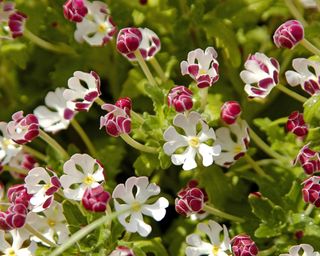5 Night-Blooming Houseplants – Grow An Indoor Moon Garden
There is something uniquely special about night-blooming houseplants. Set the scene for a magical evening indoors with these fragrant flowering beauties.


Many gardeners are embracing the idea of moon gardens filled with night-blooming flowers, often in shades of white, or with silvery foliage, that sparkle in the light of the moon.
However, you can take this idea one step further and create a magical evening scene inside your home, complete with night-blooming houseplants.
These special plants feel like an otherworldy secret, as their beauty reveals itself at night to create a serene, sweet-scented atmosphere.
Why Do Some Plants Only Bloom At Night?
Some plant species have evolved over millions of years to only open at night. The reason? They are more likely to attract the night-flying insects that pollinate them.
These night-time bloomers also tend to be white in color, yet with an aromatic aroma simply because the night-flying creatures aren't searching for them by sight, but rather by smell.
Another theory as to why some plants only open in the evening or at nightfall is to help plants in dry climates to conserve moisture and energy.
Whatever the reason, by incorporating some night-blooming houseplants into your home, you too can enjoy the mystique of a peaceful moonlit evening peppered with stars.
Gardening tips, videos, info and more delivered right to your inbox!
Sign up for the Gardening Know How newsletter today and receive a free download of our most popular eBook "How to Grow Delicious Tomatoes."
Discover 5 beautiful night-blooming houseplants that can bring the moon garden indoors.
1. Night Fragrant Orchid

The night fragrant orchid (Epidendrum nocturnum) is one of numerous types of orchids native to Florida, as well as areas of the West Indies, Mexico, and Central and northern South America.
An easy-to-grow plant, this orchid will bloom several times a year and is adapted to a variety of conditions.
It produces 4-10 dark green leaves and up to 5 blooms on a short-stemmed raceme. The blooms themselves have long, slender petals and sepals. The flower is tube-shaped with a heart-shaped lip on the lower petal, which may be daubed purple or dark red. When in bloom, the flowers produce a scent evocative of eucalyptus to anise.
This orchid prefers temperatures between 65°F to 80°F (18°C to 27°C) during the day with a 10°F (5°C) drop at night to promote blooming.
2. Lady of the Night

Lady of the night (Brunfelsia americana) is a tropical evergreen shrub that while termed a night-blooming jasmine, isn’t a jasmine at all but rather a member of the nightshade family.
Often trained as a vine outdoors, where it can get 8 to 10 feet (2.4m to 3m) tall and 3 feet (1m) across, lady of the night can also be grown indoors near a bright window.
Plants require consistently moist soil, warm temperatures, and bright light – up to six hours per day.
Not only will you get to enjoy the lovely jasmine-like blooms in the evening, but also their intense yet pleasant aroma will fill your home.
3. Orchid Cactus

The orchid cactus is so named due to its large, showy, varied-colored blooms that resemble those of an orchid.
Often aromatic, these blooms are borne on fleshy, succulent stems and come in an array of colors, from pink to purple to yellow to white.
Orchid cacti are epiphyte plants native to tropical South and Central America, where they can be found clinging to branches or trunks of trees. They absorb their nutrients and water from the host tree and the air around them.
As houseplants, you will want to mimic their natural moist, warm, humid, and shaded environment. They like plenty of humidity, consistent watering, and no full sun. Orchid cacti do well in hanging baskets, which show off their trailing stems.
4. Night Phlox

Night phlox (Zaluzianskya ovata) can be grown outside in USDA zones 9-11, or as a houseplant. Native to South Africa, night phlox has lush green foliage that makes it ideal for use as a container plant.
At night, the daisy-like blooms open to reveal their spectacular sweet honey aroma.
This phlox requires warm temperatures and moist but well-draining soil. At maturity expect the plant to attain a height of only about a foot (30cm) but a spread of 2 to 3 feet (60cm to 91cm).
5. Queen of the Night Cactus

There’s been much buzz about night-blooming flowers and the queen of the night cactus (Epiphyllum oxypetalum) is at the center of the conversation. Native to North America’s Sonoran Desert, queen of the night blooms once a year.
A low-maintenance plant, it prefers at least 6 hours of dappled or bright yet indirect light; a south-facing window in your home is ideal.
It is drought tolerant, requires normal levels of humidity, and temperatures between 68°F to 95°F (20°C to 35°C). Plant in well-draining soil that can hold moisture.
As the plant is an epiphyte in nature, fertilization is the key to successful blooms in the spring and summer months. Fertilize once per month during the growing season with a dilute food rich in phosphate and potassium before and after blooming.

Amy Grant has been gardening for 30 years and writing for 15. A professional chef and caterer, Amy's area of expertise is culinary gardening.
-
 How To Keep Peonies From Falling Over: 5 Fixes For Floppy Flowers
How To Keep Peonies From Falling Over: 5 Fixes For Floppy FlowersPeonies are cottage garden favorites, but they can be prone to flopping. Support peonies with these practical ideas that can double as attractive features.
By Melanie Griffiths
-
 9 Bird-Friendly Flowering Plants: Flowers That Attract Birds Through The Seasons
9 Bird-Friendly Flowering Plants: Flowers That Attract Birds Through The SeasonsChoose the right flowering plants and your garden will become a favorite hangout for avian visitors. Try these nine flowers that attract birds to your yard
By Tonya Barnett